2021 Volume 97 Issue 2 Pages 69-88
2021 Volume 97 Issue 2 Pages 69-88
The interconversion between spin, charge, and heat currents is being actively studied from the viewpoints of both fundamental physics and thermoelectric applications in the field of spin caloritronics. This field is a branch of spintronics, which has developed rapidly since the discovery of the thermo-spin conversion phenomenon called the spin Seebeck effect. In spin caloritronics, various thermo-spin conversion phenomena and principles have subsequently been discovered and magneto-thermoelectric effects, thermoelectric effects unique to magnetic materials, have received renewed attention with the advances in physical understanding and thermal/thermoelectric measurement techniques. However, the existence of various thermo-spin and magneto-thermoelectric conversion phenomena with similar names may confuse non-specialists. Thus, in this Review, the basic behaviors, spin-charge-heat current conversion symmetries, and functionalities of spin-caloritronic phenomena are summarized, which will help new entrants to learn fundamental physics, materials science, and application studies in spin caloritronics.
Thermoelectric effects enable direct interconversion between heat and electricity.1) One of the representative thermoelectric effects is the Seebeck effect, discovered by T. J. Seebeck in 1821. This effect converts a heat current into a charge current in metals and semiconductors. Its performance is described by the Seebeck coefficient, which is defined as the ratio of the generated electric field to the applied temperature gradient. The Onsager reciprocal of the Seebeck effect is called the Peltier effect, discovered by J. C. A. Peltier in 1834. Since the discovery of these fundamental effects, physics, materials science, and application-oriented studies on thermoelectric effects have mainly focused on thermoelectric power generation based on the Seebeck effect and electronic cooling based on the Peltier effect.
In addition to the Seebeck and Peltier effects, various thermoelectric transport phenomena appear in a conductor in the presence of a magnetic field H or in a magnetic material with spontaneous magnetization M.2) Such phenomena include the magneto-Seebeck/Peltier effect, in which the Seebeck/Peltier coefficient depends on the magnitude and direction of H or M, and the Nernst (Ettingshausen) effect, in which a heat (charge) current induces a transverse charge (heat) current perpendicular to H or M (Fig. 1). In magnetic conductors, the magneto-thermoelectric effects appear even in the absence of an external magnetic field owing to the action of the spin-orbit interaction on spin-polarized conduction electrons. Although these magneto-thermoelectric effects have been known for a long time, some of these phenomena have not been investigated in detail. The magneto-thermoelectric effects are fascinating research subjects that remain to be studied from fundamental and applied points of view.
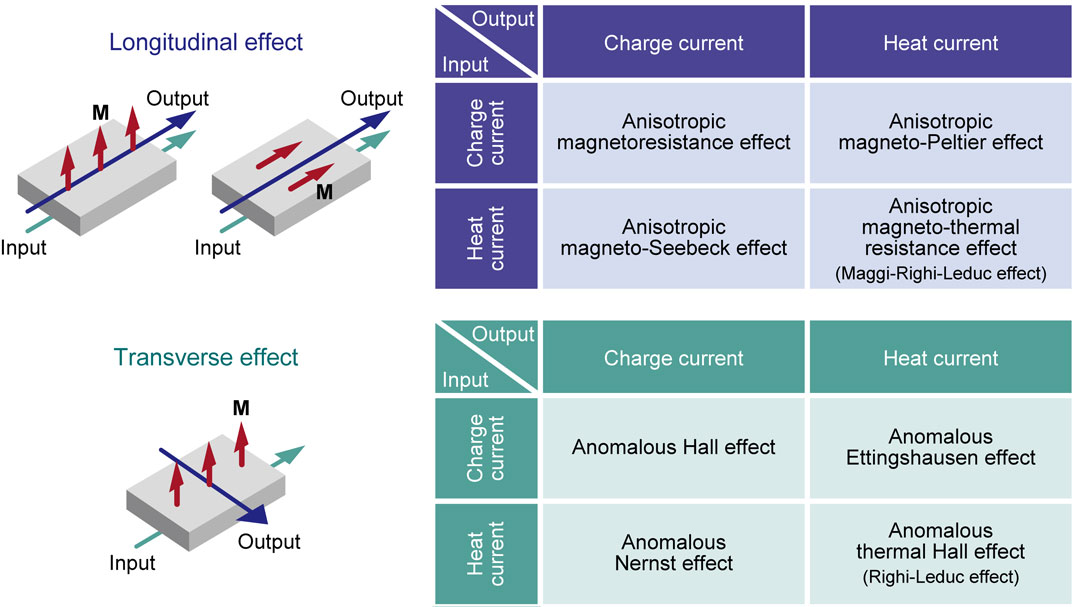
(Color online) Electric, thermal, and thermoelectric transport phenomena in magnetic materials.
In the past few decades, extensive research on spintronics, in which electron spins are actively exploited as new information and energy carriers in addition to electron charge, has been carried out all over the world.3) The field of spintronics has seen both important scientific discoveries and industrial applications, such as hard disk drive read heads, magnetoresistive sensors, and magnetic random access memories.4),5) A key concept in spintronics is the spin current, which is a pure flow of spin angular momentum without an accompanying charge current. The spin current is used for information writing and reading in spintronic devices. The concept of the spin current has also triggered the discovery of various spin-dependent and spin-driven transport phenomena; principles and techniques for generating, detecting, and controlling spin currents have developed rapidly since the beginning of the 21st century.
In this stream, the interplay between spin, charge, and heat currents has been extensively investigated. The research field based on the combination of thermoelectrics and spintronics is called spin caloritronics.2),6) This field originated from the theoretical study by Johnson and Silsbee in 1987, which established the nonequilibrium thermodynamics of the spin-charge-heat interaction in metal-based magnetic heterostructures.7) Several decades later, Hatami et al. theoretically predicted that the M direction of a ferromagnet can be reversed by a spin-polarized heat current and introduced the term “spin caloritronics”.8) One of the triggers for the rapid development of spin caloritronics is the discovery of the spin Seebeck effect (SSE), which refers to the generation of a spin current as a result of a heat current in magnetic materials.9)–12) To clarify the mechanism of the SSE, many condensed matter physicists began research on spin caloritronics. Today, spin caloritronics has grown into an interdisciplinary field which is studied worldwide. Since the discovery of the SSE, novel thermo-spin conversion principles have been discovered one after another, and unconventional thermoelectric functionalities based on spin caloritronics have been demonstrated.
The aim of this Review is to summarize the basic behaviors, spin-charge-heat current conversion symmetries, and functionalities of various spin-caloritronic phenomena. This Review is organized as follows. In Sec. 2, we focus on the conversion between charge and heat currents in magnetic materials, that is, the magneto-thermoelectric effects that depend on the M direction (Fig. 1). Although detailed explanations of magnetic-field-dependent magneto-thermoelectric effects which appear even in nonmagnetic materials are omitted, the symmetries of these effects are the same as those of the magnetization-dependent effects if the magnetization is replaced by an external magnetic field. In Sec. 3, after introducing the concept of spin currents, we review basic properties of the conversion between spin and heat currents, that is, the thermo-spin effects. Because spin currents are carried not only by conduction electrons but also by the collective dynamics of local magnetic moments, i.e., magnons, a wide variety of thermo-spin effects appear in magnetic materials and their junction structures. Section 4 is a supplementary section that summarizes spin-caloritronic phenomena other than the effects described in the previous sections. Section 5 is devoted to the conclusions and prospects. The author anticipates that this Review will further invigorate basic science and application studies on spin caloritronics, and accelerate new entry into this field from various research areas.
As summarized in Fig. 1, the conversion between charge and heat currents in magnetic materials is classified into two categories: “longitudinal effect” and “transverse effect”, in which the output current is generated in the direction parallel and perpendicular to the input current, respectively. The most well-known longitudinal electric transport phenomenon is the anisotropic magnetoresistance (AMR) effect, where the electrical resistivity changes with the relative angle θM between the M direction and the input current.13) In isotropic magnetic materials, the AMR obeys the following equation:
| \begin{equation} \rho(\theta_{\text{M}}) = \rho_{\bot} + (\rho_{\|} - \rho_{\bot})\cos^{2}\theta_{\text{M}}, \end{equation} | [1] |
The longitudinal thermoelectric effects in magnetic materials are called the anisotropic magneto-Seebeck effect (AMSE) and the anisotropic magneto-Peltier effect (AMPE), where the Seebeck and Peltier coefficients depend on θM, respectively.15)–29) The θM dependence of the Seebeck coefficient S is similar to that of the AMR; if the magnetic material is isotropic, the symmetry of S is expressed as
| \begin{equation} S(\theta_{\text{M}}) = S_{\bot} + (S_{\|} - S_{\bot})\cos^{2}\theta_{\text{M}}, \end{equation} | [2] |
Figure 2 shows an example of the experimental results of the AMSE in a polycrystalline Ni slab with a rectangular shape.25) The electric voltage between the ends of the Ni slab was measured at room temperature with applying a temperature gradient ∇T along the y direction and H (with the magnitude H) in the direction perpendicular or parallel to the ∇T direction (Figs. 2(a) and 2(b)). Figures 2(c) and 2(d) show the voltage difference ΔV in the Ni slab as a function of H for various values of the temperature difference ΔT, where ΔV was obtained by removing the offset due to the H-independent thermopower. The ΔV signals exhibit clear H-even dependence; when H ⊥ ∇T (H || ∇T), the magnitude of ΔV increases (decreases) with increasing |H| and the field-induced change of ΔV is proportional to ΔT (Fig. 2(e)). Importantly, the ΔV signals in the H ⊥ ∇T (H || ∇T) configuration saturate at around μ0H = 0.4 T (0.1 T), which corresponds to the saturation field of the Ni slab (note that the difference in the saturation field is due to the shape magnetic anisotropy). This result indicates that the behavior of ΔV is determined by M, not H. The H-even dependence of the thermopower is a feature of the AMSE (see Eq. [2] and note that the asymmetric field dependence of the Seebeck coefficient called the Umkehr effect30) is absent in isotropic polycrystalline materials). The anisotropy of the Seebeck coefficient in the Ni slab was estimated to be ∼3% at room temperature. As shown in the above example, the AMSE can be investigated simply by measuring the magnetic field dependence of the longitudinal thermopower. Since such measurements are well established, many experiments on the AMSE have been reported so far.
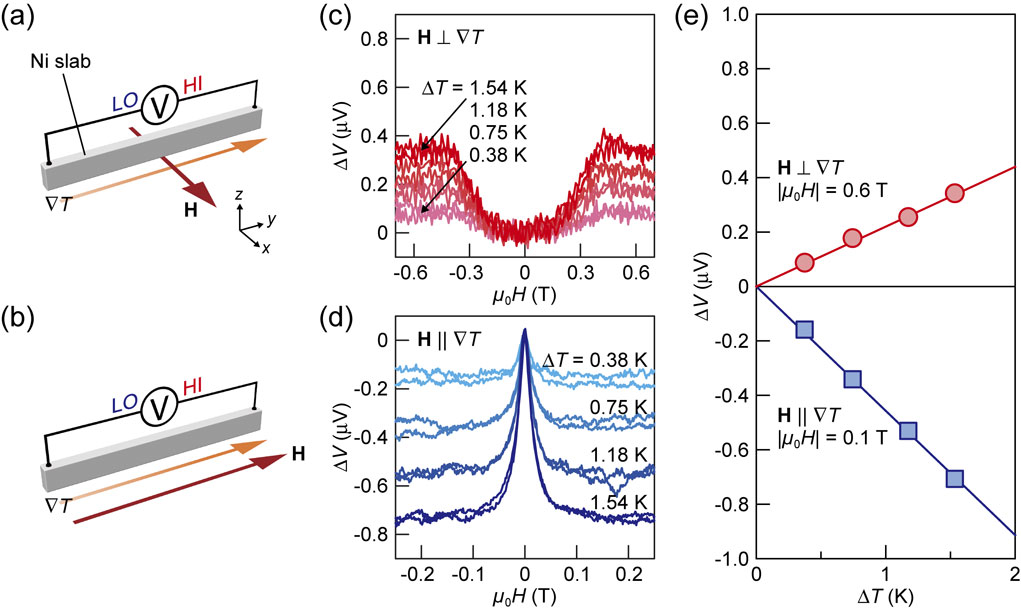
(Color online) (a),(b) Schematic illustrations of the setups for measuring the AMSE. The electric voltage between the ends of the straight Ni slab along the temperature gradient ∇T was measured with applying a magnetic field H in the directions (a) perpendicular and (b) parallel to ∇T. (c),(d) The magnetic field μ0H dependence of the voltage ΔV in the Ni slab for various values of the temperature difference ΔT, measured for the (c) H ⊥ ∇T and (d) H || ∇T configurations. The voltage offset due to the H-independent thermopower was subtracted. The magnitude of the AMSE signal in the H || ∇T configuration is twice as large as that in the H ⊥ ∇T configuration, in a similar manner to the AMR. (e) ΔT dependence of ΔV in the Ni slab at |μ0H| = 0.6 T (0.1 T) in the H ⊥ ∇T (H || ∇T) configuration. The details on these experiments are described in Ref. 25.
Meanwhile, the direct observation of the AMPE requires unconventional thermal measurement techniques. In 2018, we realized the observation of the temperature modulation induced by the AMPE by using the active infrared emission microscopy technique called lock-in thermography (LIT).25),31),32) In the experiments of thermoelectric effects based on the LIT, the spatial distribution of infrared radiation thermally emitted from the surface of a sample is measured using an infrared camera while applying a square-wave-modulated AC charge current Jc with the amplitude Jc, frequency f, and zero DC offset to the sample. The thermal images oscillating with the same frequency as the input charge current are extracted through Fourier analysis. The contribution of the thermoelectric effects (∝ Jc) can be separated from the Joule-heating background (∝ Jc2) by extracting the first harmonic response of the thermal images, because the Joule heating generated in this condition is constant with time. As a result of the Fourier analysis, the obtained thermal images are transformed into the lock-in amplitude A and phase ϕ images, which show the distributions of the magnitude and sign of the current-induced temperature modulation, respectively. The ϕ image also includes the information on the time delay of the temperature modulation due to thermal diffusion.
The heat release and absorption induced by the AMPE appear on the boundaries between the areas with different θM values, even in the absence of junction structures. One of the simple ways to create such boundaries is to form a non-uniform magnetization configuration, as illustrated in Fig. 3(a). However, non-uniform magnetization configurations are not suitable for systematic measurements because it is difficult to change the magnetization distribution with high controllability. Therefore, the temperature modulation induced by the AMPE has been observed mainly in uniformly magnetized U-shaped materials, where a charge current is applied along the U-shaped structure (Fig. 3(b)). This configuration also leads to the non-uniform θM distribution; the AMPE-induced temperature modulation appears around the corners of the U-shaped structure, that is, the regions between the area satisfying M ⊥ Jc and the area satisfying M || Jc. Figure 3(d) shows an example of the experimental results of the AMPE in a polycrystalline Ni film with a U-shaped structure, measured by the LIT technique.28) The LIT images were measured while applying H in the x-y plane at an azimuthal angle θH from the +x direction (Fig. 3(f)). The pure AMPE contribution was separated from other thermoelectric contributions by measuring the dependence of the LIT images on the sign and/or angle of the magnetic field.25),28) When θH = 0°, we observed clear temperature-modulation signals appearing predominantly around the corners (areas 2 and 4 in Fig. 3(f)) of the U-shaped structure. The sign of the temperature modulation on the area 2 is opposite to that on the area 4 because of the lock-in phase difference of ∼180°. We also confirmed that the sign of the AMPE signal is reversed at θH = 90° and the signal disappears at θH = 45°; the θH dependence of the AMPE signals follows the cos 2θH symmetry (Fig. 3(e)). This behavior is consistent with Eq. [2] based on the trigonometric relations between θM and θH. As demonstrated here, the AMPE enables thermoelectric cooling and heating in a single material without junction structures. Owing to the absence of junctions, the thermoelectric output of the AMPE can be enhanced by constructing simple thermopile structures26) and reconfigured by changing the shape of the magnetic materials or the magnetization configuration. These characteristics provide new concepts in thermal management technologies for electronic and spintronic devices.
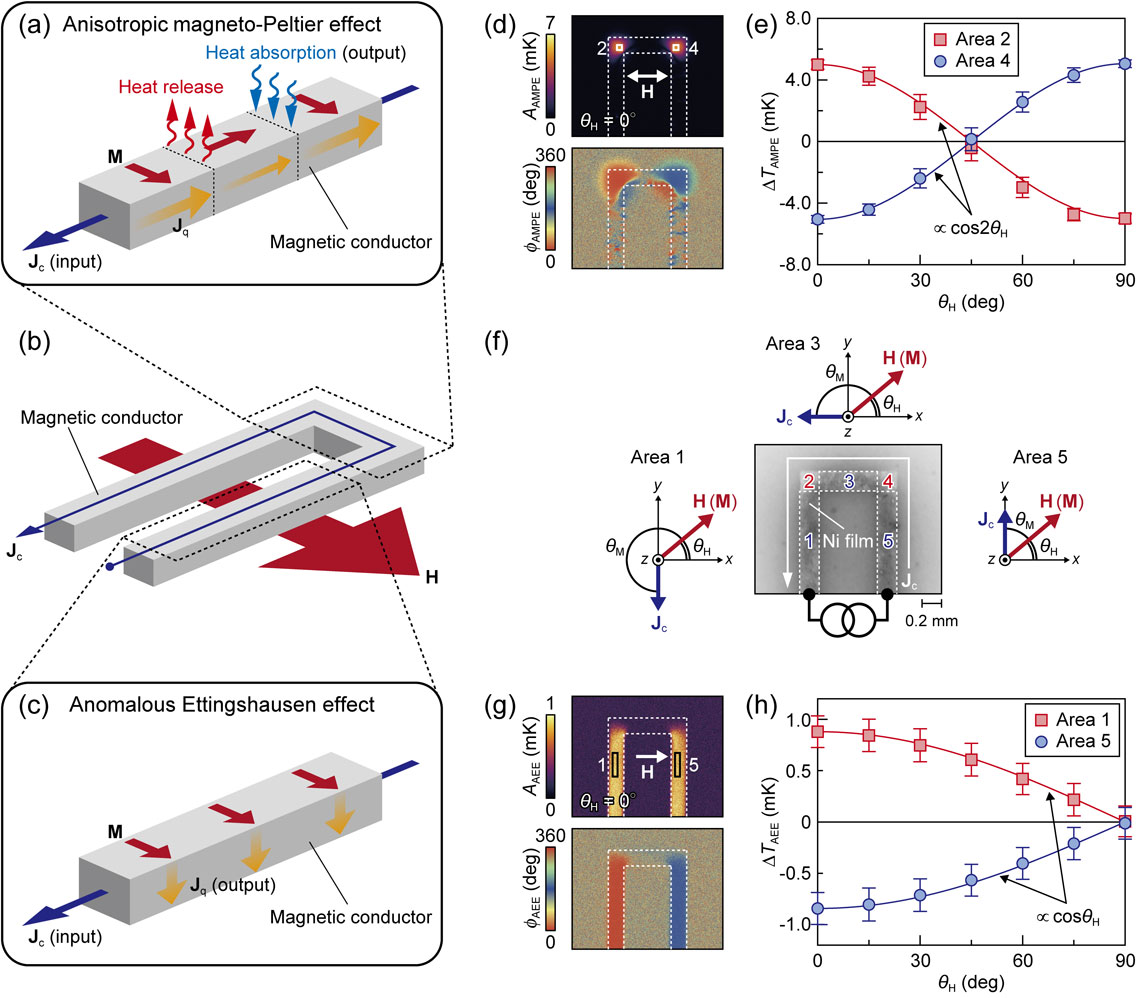
(Color online) (a) A schematic illustration of the AMPE in a magnetic conductor with a non-uniform magnetization M configuration. (b) A schematic illustration of a U-shaped magnetic conductor typically used for measuring the AMPE and AEE. (c) A schematic illustration of the AEE in a uniformly magnetized magnetic conductor. Jc, Jq, and H denote the charge current applied to the magnetic conductor, heat current induced by the Peltier effect or the AEE, and magnetic field, respectively. (d) Lock-in amplitude AAMPE and phase ϕAMPE images showing the AMPE-induced temperature modulation for the U-shaped 100-nm-thick Ni film on a glass substrate, measured at the field angle of θH = 0°, charge current amplitude of 40 mA, and lock-in frequency of 25 Hz. (e) θH dependence of ΔTAMPE (= AAMPE cos ϕAMPE) on the areas 2 and 4 of the U-shaped Ni film. The solid curves show the cos 2θH functions. (f) Steady-state infrared image of the U-shaped Ni thin film with black-ink coating and the definitions of θH and θM. θH (θM) represents the angle between H and the +x direction (between M and Jc), where M is aligned along H. The areas 1, 3, and 5, surrounded by white dotted lines, and the areas 2 and 4, the corner of the U-shaped structure, represent different parts of the Ni film. (g) Lock-in amplitude AAEE and phase ϕAEE images showing the AEE-induced temperature modulation for the U-shaped 100-nm-thick Ni film on a sapphire substrate, measured at θH = 0°, charge current amplitude of 75 mA, and lock-in frequency of 25 Hz. (h) θH dependence of ΔTAEE (= AAEE cos ϕAEE) on the areas 1 and 5 of the U-shaped Ni film. The solid curves show the cos θH function. The details on these experiments are described in Ref. 28.
Because the thermoelectric performance of the AMSE/AMPE is still very low compared with conventional thermoelectric devices, it is necessary to find or develop magnetic materials with large anisotropy of the Seebeck/Peltier coefficient. To improve the thermoelectric performance, the AMSE/AMPE was measured not only in Ni but also in various ferromagnetic metals.25),29) Although Ni exhibits clear anisotropy of the Seebeck/Peltier coefficient, the AMSE/AMPE in polycrystalline Fe was observed to be negligibly small. This behavior is quantitatively reproduced by first-principles-based Boltzmann transport calculations, which clarified that spin-flip electron transitions due to the spin-orbit interaction are the key mechanism in the AMSE/AMPE.27) The magnitude of the AMSE/AMPE signals in Ni95Pt5 and Ni95Pd5 was found to be larger than that in pure Ni; the anisotropy of the Seebeck/Peltier coefficient of Ni95Pt5 reaches ∼12%. However, the experiments also show that excess Pt and Pd contents decrease the anisotropy of the coefficient. These results indicate that the doping of heavy elements with strong spin-orbit interaction to ferromagnetic materials is useful for improving the thermoelectric conversion efficiency of the AMSE/AMPE, but the material dependence in such alloys is not simple and not fully understood. However, materials science studies to find magnetic materials that show large AMSE/AMPE are already in progress. In this vein, Masuda et al. predicted that several ferromagnetic ordered alloys exhibit very large anisotropy of the Seebeck/Peltier coefficient.27) The experimental demonstration of this prediction is desired.
2.2. Transverse magneto-thermoelectric effects.The transverse thermoelectric effects in magnetic materials are called the anomalous Nernst effect (ANE)33)–44) and the anomalous Ettingshausen effect (AEE),45)–52) which are the thermoelectric analogues of the AHE. In the ANE (AEE), an input heat (charge) current induces a transverse charge (heat) current in the direction perpendicular to the M direction. The symmetries of the ANE and AEE are respectively expressed as46)
| \begin{equation} \mathbf{j}_{\text{c,ANE}} = \sigma S_{\text{ANE}}(\mathbf{m} \times \nabla T), \end{equation} | [3] |
| \begin{equation} \mathbf{j}_{\text{q,AEE}} = \sigma\Pi_{\text{AEE}}(\mathbf{m} \times \nabla V). \end{equation} | [4] |
| \begin{equation} \Pi_{\text{AEE}} = S_{\text{ANE}}T, \end{equation} | [5] |
The ANE can be characterized by measuring the magnetic field dependence of the transverse thermopower in magnetic materials. Following Eq. [3], the ANE thermopower exhibits the odd dependence on the magnetization direction, that is, the H-odd dependence. In contrast to isotropic bulk materials, ANE measurements for thin films are performed in two different configurations due to the huge difference between the in-plane and out-of-plane dimensions. One configuration is the in-plane magnetized (IM) configuration, where H (∇T) is applied along the in-plane (out-of-plane) direction (Fig. 4(a)). The IM configuration is suitable for thermal energy harvesting and heat sensing applications because ANE-based thermoelectric generation can be realized simply by forming films onto heat sources. In contrast, it is difficult to estimate SANE quantitatively in the IM configuration because of the difficulty in estimating the temperature difference between the top and bottom of thin films.57) The other configuration is the perpendicularly magnetized (PM) configuration, where H (∇T) is applied along the out-of-plane (in-plane) direction (Fig. 4(b)). The PM configuration is widely used for the quantitative estimation of SANE, although it often requires a large magnetic field to align M of films along the out-of-plane direction.
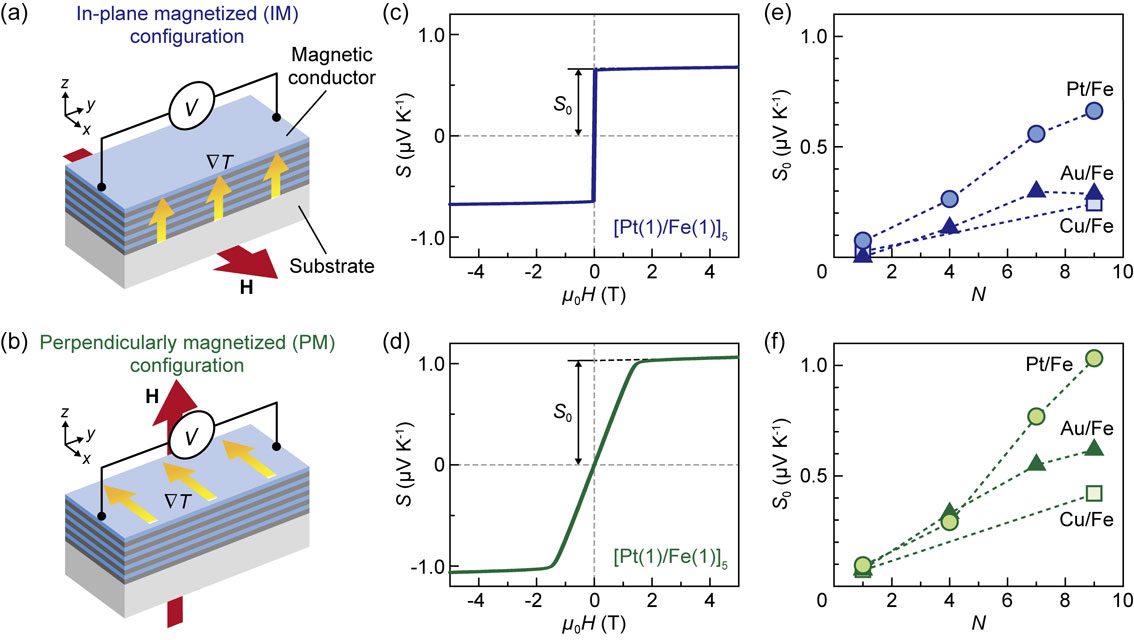
(Color online) (a),(b) Schematic illustrations of the (a) IM and (b) PM configurations used for measuring the ANE in a magnetic conductor film on an insulating substrate. (c),(d) μ0H dependence of the transverse thermopower S in the [Pt(1)/Fe(1)]5 multilayer film in the (c) IM and (d) PM configurations. The numbers in parentheses represent the layer thickness in nanometers and the subscript represents the number of the Pt/Fe bilayers, indicating that the total thickness of the [Pt(1)/Fe(1)]5 multilayer film is 10 nm. S0 is the ANE contribution in the thermopower. (e),(f) N dependence of S0 in the Pt/Fe, Au/Fe, and Cu/Fe multilayer films in the (e) IM and (f) PM configurations. N denotes the number of the nonmagnetic metal/Fe interfaces. The total thickness of the multilayers is fixed at 10 nm, indicating that the interface density increases with increasing N. The details on these experiments are described in Ref. 37.
Figure 4 shows an example of the experimental results of the ANE in multilayer films comprising alternately stacked ferromagnetic and nonmagnetic metals.37) Here, the multilayer film can be regarded as a single effective magnetic material. Figures 4(c) and 4(d) show the μ0H dependence of the transverse thermopower S in a Pt/Fe multilayer film formed on a single-crystalline Gd3Ga5O12 (111) substrate in the IM and PM configurations, respectively. S is defined as (V/ΔT)(Lz/Ly) in the IM configuration and (V/ΔT)(Lx/Ly) in the PM configuration, where V is the voltage between the ends of the film, ΔT is the temperature difference between the ends of the sample including the substrate, and Lx,y,z is the length of the sample along the x, y, and z directions. The S values exhibit clear H-odd dependence and saturate when M is aligned along H, indicating that the ANE provides the dominant contribution to the transverse thermopower and that the field-induced ordinary Nernst effect is negligibly small. The ANE-driven transverse thermopower S0 can be extracted by extrapolating the S data in the high field region to zero field. Note that S0 ≠ SANE in the IM configuration because of the difference in the thermal conductivities between the film and substrate, while S0 = SANE in the PM configuration because of the same temperature difference in the film and substrate.
For practical applications of the ANE, it is important to find and develop magnetic materials with large SANE. In general, SANE can be divided into two components as42),49)
| \begin{equation} S_{\text{ANE}} = \rho_{xx}\alpha_{xy} + \rho_{xy}\alpha_{xx}, \end{equation} | [6] |
In the field of spin caloritronics, various conversion phenomena between spin and heat currents have been discovered and investigated. The principles of such thermo-spin effects are conceptually different from the magneto-thermoelectric effects summarized in Sec. 2. In this section, we first review the definition of spin currents, followed by a summary of the basic behaviors and symmetries of typical thermo-spin effects.
3.1. Definition of spin current.The charge current density jc is defined by the continuity equation for the charge density ρ as
| \begin{equation} \frac{d\rho}{dt} = - \nabla \cdot \mathbf{j}_{\text{c}}, \end{equation} | [7] |
| \begin{equation} \frac{d\mathbf{M}}{dt} = - \gamma \nabla \cdot \mathbf{j}_{\text{s}} + \mathbf{T}, \end{equation} | [8] |
When an external force, such as an electric field, is applied to metals or semiconductors, a nonequilibrium charge current is driven by conduction electrons on the Fermi surface. In a similar way, spins can be carried by conduction electrons acted on by an external force; the conduction electron spin current exists only in electric conductors. Assuming that the spin quantization axis is fixed, the charge current Jc and conduction electron spin current Js are respectively expressed as
| \begin{equation} \mathbf{J}_{\text{c}} = e(\mathbf{J}_{\uparrow} + \mathbf{J}_{\downarrow}), \end{equation} | [9] |
| \begin{equation} \mathbf{J}_{\text{s}} = \frac{\hbar}{2}(\mathbf{J}_{\uparrow} - \mathbf{J}_{\downarrow}), \end{equation} | [10] |
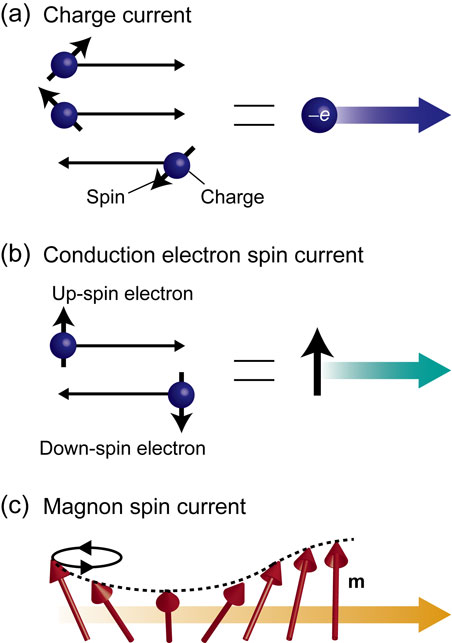
(Color online) Schematic illustrations of (a) the charge current, (b) the conduction electron spin current, and (c) the magnon spin current. −e and m denote the electron charge and the magnetic moment, respectively.
A magnon is a quasiparticle of a spin wave, which is the collective dynamics of localized magnetic moments in magnetic materials. The magnon spin current is the flow of spin angular momentum carried by magnons (Fig. 5(c)). The magnon spin current can exist even in magnetic insulators with no conduction electrons, and is always a pure spin current because magnons have no charge. Magnons follow the Bose-Einstein statistics, and are thermally excited in magnetic materials at finite temperatures. However, a net flow of spin angular momentum, that is, the magnon spin current, is not generated under thermal equilibrium conditions because magnons with wavenumbers k and −k exist in equal numbers. The magnon spin current is generated when there is an imbalance in the numbers of k and −k magnons due to some external forces. The magnon dynamics can be obtained by solving the Landau-Lifshitz-Gilbert equation, which is the equation of motion for magnetic moments:
| \begin{equation} \frac{d\mathbf{m}}{dt} = -\gamma \mathbf{m} \times \mathbf{H}_{\text{eff}} + \frac{\alpha}{M_{\text{s}}}\mathbf{m} \times \frac{d\mathbf{m}}{dt}. \end{equation} | [11] |
The magnon spin current in a magnetic material and the conduction electron spin current in a metal can be interconverted via the interfacial exchange interaction at the magnetic material/metal junction, which is known as the spin-mixing conductance68) (Fig. 6). The spin-mixing conductance enables the generation of magnon spin currents by injecting conduction electron spin currents into magnetic materials. Furthermore, it enables the detection of magnon spin currents by converting them into conduction electron spin currents. This interconversion is essential in the SSE and its Onsager reciprocal called the spin Peltier effect (SPE), discussed in Sec. 3.3.
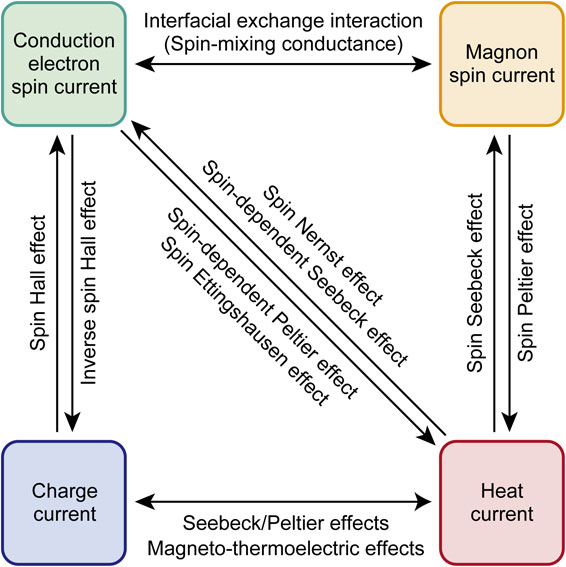
(Color online) Conversion phenomena between spin, charge, and heat currents. The magneto-thermoelectric effects summarized in Fig. 1 are included in the conversion between charge and heat currents. Spin-current transport phenomena are conceptually different from the magneto-thermoelectric effects.
Let us recall the longitudinal electron transport in a conductor. The charge current density jc and heat current density jq are driven by the electrochemical potential gradient ∇μ and temperature gradient ∇T. The linear-response transport can be expressed as
| \begin{equation} \begin{pmatrix} \mathbf{j}_{\text{c}}\\ \mathbf{j}_{\text{q}} \end{pmatrix} = \begin{pmatrix} L_{11} & L_{12}\\ L_{21} & L_{22} \end{pmatrix}\begin{pmatrix} -\nabla \mu /e\\ -\nabla T \end{pmatrix} , \end{equation} | [12] |
The conduction electron spin current (with the density js) extends the electron transport phenomena. The transport phenomena in ferromagnetic conductors are often represented by up- and down-spin electron flows when the spin quantization axis is fixed. Here, not only the electrical conductivity and (electronic) thermal conductivity but also the Seebeck and Peltier coefficients exhibit spin dependence. For example, the electrical conductivity for up-spin electrons σ↑ is different from that for down-spin electrons σ↓ in ferromagnetic conductors. The driving forces in the spin-dependent electron transport are the spin-dependent electrochemical potential gradient ∇μ↑,↓ and ∇T, and the transport equation is expressed as
| \begin{equation} \begin{pmatrix} \mathbf{j}_{\text{c}}\\ \mathbf{j}_{\text{s}}\\ \mathbf{j}_{\text{q}} \end{pmatrix} = \begin{pmatrix} M_{11} & M_{12} & M_{13}\\ M_{21} & M_{22} & M_{23}\\ M_{31} & M_{32} & M_{33} \end{pmatrix}\begin{pmatrix} -\nabla (\mu_{\uparrow} + \mu_{\downarrow})/e\\ -\nabla (\mu_{\uparrow} - \mu_{\downarrow})/e\\ -\nabla T \end{pmatrix} , \end{equation} | [13] |
The rapid development of spin caloritronics was triggered by the discovery of the SSE in which a spin current is generated as a result of a temperature gradient applied to a junction system comprising a magnetic material and a conductor. Because the first experiment on the SSE reported in 2008 was performed using a junction of a ferromagnetic metal (Ni81Fe19) and a paramagnetic metal (Pt),9) the SSE was initially discussed in terms of spin transport by conduction electrons, i.e., the aforementioned spin-dependent Seebeck effect, which occurs only in metals and semiconductors.73) However, it was experimentally demonstrated in 2010 that the SSE occurs in a magnetic insulator in which transport by conduction electrons is completely frozen.10),12) These experiments upset the conventional interpretation and revealed that the SSE originates from thermally excited magnon transport, because magnons can carry spin currents even in insulators.74)–80) Since the discovery of the SSE in magnetic insulators, the experimental techniques and theoretical understanding of this phenomenon have developed dramatically. Most of the recent SSE experiments were performed using magnetic insulators because the insulator-based systems allow us to obtain a relatively large heat-spin current conversion capability and to separate the contribution of the conduction-electron-driven magneto-thermoelectric effects from the magnon-spin-current contribution, enabling systematic and reliable investigation of the SSE.81) Considering the difference in the driving carriers between the SSE and the spin-dependent Seebeck effect, it may be expected that the former would be referred to as “magnon Seebeck effect” and the latter as “spin Seebeck effect”. However, as mentioned above, the SSE experiment was reported earlier than the observation of the spin-dependent Seebeck effect by Slachter et al. In addition, the term “spin Seebeck effect” and the experimental method in Ref. 9 were already widely used in 2010 when the direct observation of the spin-dependent Seebeck effect was reported. Thus, the spin-caloritronics community has decided to continue to refer to the magnon-driven thermo-spin conversion as the SSE, while the conduction-electron-driven thermo-spin conversion is distinguished from the SSE by calling it the spin-dependent Seebeck effect.6) Although the terminologies of the thermo-spin effects may be confusing because of the historical reasons, the SSE and the spin-dependent Seebeck effect are completely different phenomena. The same situation also applies to the magnon-driven SPE and the conduction-electron-driven spin-dependent Peltier effect (Fig. 6).
Here, the basic mechanism and behavior of the SSE are summarized. A typical system used for measuring the SSE is a junction structure consisting of a ferrimagnetic insulator YIG and a paramagnetic metal Pt. When ∇T is applied to YIG, a magnon spin current is generated along the gradient due to the thermally excited dynamics of localized magnetic moments (Fig. 7(a)). The magnon spin current in YIG is converted into a conduction electron spin current with the spatial direction Js and the spin polarization vector $\boldsymbol{\sigma}$ in the Pt layer via the spin-mixing conductance at the Pt/YIG interface, where Js is normal to the Pt/YIG interface plane and $\boldsymbol{\sigma}$ is parallel to M of YIG. This conduction electron spin current in the Pt layer is then converted by the strong spin-orbit interaction into the charge current Jc satisfying the following symmetry:
| \begin{equation} \mathbf{J}_{\text{c}} \propto \boldsymbol{\sigma} \times \mathbf{J}_{\text{s}}. \end{equation} | [14] |

(Color online) (a) A schematic illustration of the SSE in a junction system comprising a magnetic insulator (e.g., YIG) and a metal film (e.g., Pt). The SSE in this configuration is called the longitudinal SSE, because the input temperature gradient and output spin current are parallel to each other. Js denotes the spatial direction of the spin current. The spin polarization vector (black arrows) in the metal layer is aligned along the m direction in the insulator layer. (b) Temperature T dependence of the saturation magnetization Ms of the YIG slab. (c) T dependence of the transverse thermopower induced by the SSE SSSE in the Pt-film/YIG-slab junction system and the thermal conductivity κ of the single-crystalline YIG slab. (d) A schematic illustration of the SPE in a junction system comprising a magnetic insulator and a metal film. (e) μ0H dependence of the temperature modulation induced by the SPE ΔTSPE in the Pt/YIG system for various values of the input charge current Jc. The inset to (e) shows the Jc dependence of ΔTSPE at μ0|H| = 0.1 and 8.0 T. The details on these experiments are described in Refs. 86 and 95.
A typical temperature-dependent behavior of the SSE-induced transverse thermopower, i.e., the ISHE voltage induced by the SSE, is shown in Fig. 7(c).86) The sample system used in this experiment is a junction comprising a single-crystalline YIG slab and a Pt thin film. The SSE thermopower appears at temperatures lower than the Curie temperature of YIG and disappears at absolute zero temperature. The temperature dependence of the SSE thermopower is completely different from the magnetization curve of YIG (compare Fig. 7(b) and 7(c)). When single-crystalline YIG is used, the SSE thermopower increases with decreasing temperature and exhibits a peak at ∼30 K. The temperature at which the thermopower reaches its maximum is comparable to that at which the thermal conductivity of the single-crystalline YIG becomes maximum, where the thermal conductivity of YIG is determined mainly by phonon transport. Therefore, the steep peak signal may be related to the phonon drag effect on the SSE.87),88) There is also another argument that the low-temperature enhancement of the SSE thermopower is determined not only by the phonon drag effect but also by the enhancement of the magnon propagation length because the temperature dependences of the SSE thermopower and thermal conductivity differ at temperatures higher than the peak temperature. Although YIG is still most widely used in spin caloritronics, the SSE has been observed in various materials including ferro(ferri)magnetic, paramagnetic,89) antiferromagnetic,90),91) multiferroic,92) and quantum spin materials,65) indicating that the SSE is a universal transport phenomenon appearing in a wide variety of materials.
The symmetry of the SSE thermopower is similar to but different from that of the ANE thermopower. The SSE can be separated from the ANE by comparing the transverse thermopower in the IM configuration (Fig. 8(a)) and the PM configurations (Fig. 8(b)).56),57) As shown above, in the IM configuration, both the SSE and ANE exhibit the transverse thermopower of which the sign is reversed by reversing M. In contrast, in the PM configuration, the SSE thermopower disappears due to the symmetry of the ISHE (see Eq. [14] and note that $\mathbf{J}_{\text{s}}\parallel \boldsymbol{\sigma}$ in the PM configuration), while the ANE thermopower can appear because the ∇T, M, and inter-electrode directions are at right angles to one another. In fact, an isotropic ferromagnetic metal film was shown to exhibit isotropic ANE thermopower in the IM and PM configurations (Figs. 8(c) and 8(d)), while the Pt/YIG system exhibits no thermopower in the PM configuration, except for the small contribution from the ordinary Nernst effect in the Pt layer (Figs. 8(e) and 8(f)). This comparison confirms that the SSE is irrelevant to the ANE induced by the magnetic proximity effect93) near the Pt/YIG interface.
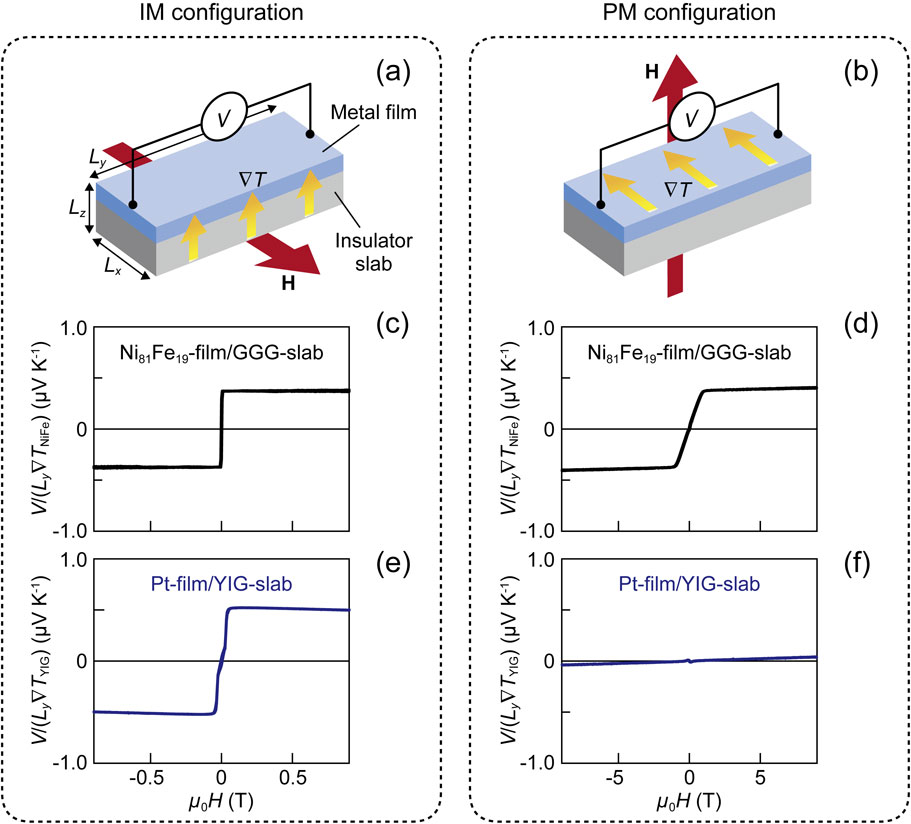
(Color online) (a),(b) Schematic illustrations of the metal film/insulator slab junction system in the (a) IM and (b) PM configurations. Lx, Ly, and Lz denote the width, length, and thickness of the system, respectively. (c),(d) μ0H dependence of the transverse thermopower in the Ni81Fe19-film/Gd3Ga5O12 (GGG)-slab junction system in the (c) IM and (d) PM configurations. The thermopower is defined as the thermoelectric voltage V normalized by the temperature gradient in the Ni81Fe19 film ∇TNiFe and Ly. (e),(f) μ0H dependence of the transverse thermopower in the Pt-film/YIG-slab junction system in the (e) IM and (f) PM configurations. The thermopower is defined as V normalized by the temperature gradient in the YIG slab ∇TYIG and Ly. The details on these experiments are shown in Ref. 57.
The Onsager reciprocal of the SSE is the SPE, in which a heat current is generated as a result of a spin current (Fig. 6). It was first experimentally observed in 2014 by Flipse et al., who also used Pt/YIG junction systems.94) As schematically illustrated in Fig. 7(d), the SPE appears through the inverse process of the SSE. When Jc is applied to the Pt film, a conduction electron spin current is generated in the direction of the film thickness by the SHE, and the spin accumulation occurs near the Pt/YIG interface. The spin accumulation is polarized in the direction that satisfies the following relationship:66)
| \begin{equation} \mathbf{J}_{\text{s}} \propto \boldsymbol{\sigma} \times \mathbf{J}_{\text{c}}. \end{equation} | [15] |
| \begin{equation} \mathbf{J}_{\text{q}} \propto (\boldsymbol{\sigma} \cdot \mathbf{M}) \mathbf{n}, \end{equation} | [16] |
Because the observation of the SPE requires highly sensitive and accurate temperature measurements for thin-film devices, it is more challenging than the SSE experiments. In fact, few experimental studies on the SPE were reported for several years after its discovery until the establishment of versatile measurement methods for the spin-current-induced temperature change. In 2016, we applied the LIT technique to the measurement of the SPE, and successfully visualized the spin-current-induced temperature change and its unique spatial distribution.32) The LIT method enables the measurement of the SPE with high temperature and spatial resolutions in a simple and versatile sample structure, which does not require micro/nanofabrication techniques. Based on the knowledge obtained from the LIT measurements, the SPE was subsequently observed by using a thermocouple sensor95) as well as a lock-in thermoreflectance method.96) Figure 7(e) displays an example of the direct measurement of the temperature change due to the SPE by attaching a thin thermocouple to the surface of a Pt-film/single-crystalline YIG junction system.95) This result indicates that the temperature change increases in proportion to the charge current applied to the Pt layer and that the sign of the temperature change is reversed in response to the magnetization reversal of YIG. It is also important to note that the temperature change signal is suppressed when a strong magnetic field is applied. This behavior results from the suppression of the thermal excitation of magnon spin currents due to the Zeeman gap under a strong magnetic field.83),95) Systematic studies on the SPE performed using various measurement techniques have led to the elucidation of its detailed behavior. Theoretical studies on the SPE have also been reported.97)–99)
In Secs. 2 and 3, we discussed the magneto-thermoelectric and thermo-spin effects in magnetic materials and their simple junction structures. In addition to such simple systems, spin-caloritronic phenomena also appear in giant magnetoresistance (GMR) and tunneling magnetoresistance (TMR) devices, which form the core of spintronic technologies. In the GMR (TMR) device in which a nonmagnetic metal (insulator) film is sandwiched between two ferromagnetic metal films, the electrical resistivity is larger when the magnetization directions of the adjacent ferromagnetic layers are antiparallel than when they are parallel (Fig. 9). The switching of the magnetization configuration can be achieved by a magnetic field or spin injection. By utilizing this property, high-performance magnetic sensors and memories have been developed in spintronics, and many researchers are conducting materials science and device engineering studies to further improve the performance of the GMR and TMR devices.4),5) In such multilayer devices, not only the electrical resistivity but also the thermal conductivity100) and the Seebeck/Peltier coefficients101)–104) can change depending on whether the magnetization directions of the ferromagnetic layers are parallel or antiparallel. Improved thermoelectric conversion efficiency and thermal conductivity switching ratio may make the principles and technologies of spin caloritronics useful for the thermal management of electronic and spintronic devices.

(Color online) A schematic illustration of the electric and thermal transport phenomena in a GMR or TMR device. In GMR and TMR devices, two ferromagnetic (FM) metal films are separated by a nonmagnetic (NM) metal and insulator film, respectively. The transport coefficients in such structures are switched by changing the magnetization configuration of the FM layers from parallel to antiparallel, and vice versa.
All the thermo-spin effects introduced in Sec. 3 can be classified as the longitudinal effects because spin and heat currents flow parallel to each other. Recently, basic studies on the transverse thermo-spin effects have also been conducted. For example, in 2017, several groups reported the observation of the spin Nernst effect,105)–107) which is the thermal analogue of the SHE. In the spin Nernst effect, a conduction electron spin current is generated in nonmagnetic conductors via the spin-orbit interaction in the direction perpendicular to the applied heat current (Fig. 6). These experiments suggest the existence of the spin Ettingshausen effect, the reciprocal of the spin Nernst effect, and its direct observation is desired. As reviewed above, the development of novel phenomena, principles, and functionalities based on the interplay between spin, charge, and heat currents is still ongoing in spin caloritronics.
We have reviewed the thermoelectric effects unique to magnetic materials, i.e., the magneto-thermoelectric effects, and the conversion phenomena between spin and heat currents, i.e., the thermo-spin effects. Although only several examples of such phenomena are introduced in this Review, new principles and phenomena are discovered in spin caloritronics every year. The background to this rapid development lies in the fact that the 2 × 2 transport coefficient matrix representing charge and heat transport phenomena (Eq. [12]) is extended to the 3 × 3 matrix by including a spin current (Eq. [13]), which results in a significant increase in the variety of transport phenomena. Moreover, the introduction of other spin transport carriers, such as magnons, has brought about a wider variety of thermo-spin conversion phenomena. Research fields in which novel phenomena are discovered frequently are extremely rare and there is a significant amount of physics that remains unclear in spin caloritronics. The exploration of new principles has motivated numerous experimental and theoretical researchers to study spin-caloritronic phenomena.
What is the significance of spin caloritronics from the viewpoint of applications? One of the answers to this question is the utilization of novel functionalities provided by the spin degree of freedom, which cannot be realized with conventional thermal energy engineering and thermoelectric technologies. Employing the transport phenomena introduced in this Review, various thermoelectric generation and thermal management functionalities can be realized, including the following:
The experimental results shown in this Review were obtained from the collaboration with S. Daimon, R. Das, D. Hou, R. Iguchi, R. Itoh, X.-F. Jin, T. Kikkawa, T. Oyake, K. Oyanagi, Z. Qiu, E. Saitoh, T. Seki, J. Shiomi, Y. Shiomi, and K. Takanashi. The author thanks many collaborators and group members for valuable discussions and supports and R. Iguchi, T. Hirai, and R. Modak for preliminary reviews of the manuscript. This work was partially supported by CREST “Creation of Innovative Core Technologies for Nano-enabled Thermal Management” (JPMJCR17I1) and PRESTO “Phase Interfaces for Highly Efficient Energy Utilization” (JPMJPR12C1) from JST, Japan; Grant-in-Aid for Challenging Exploratory Research (26600067) and Grant-in-Aid for Scientific Research (A) (15H02012) from JSPS KAKENHI, Japan; and the NEC Corporation.
Edited by Hiroyuki SAKAKI, M.J.A.
Correspondence should be addressed: K. Uchida, Research Center for Magnetic and Spintronic Materials (CMSM), National Institute for Materials Science (NIMS), 1-2-1 Sengen, Tsukuba, Ibaraki 305-0047, Japan (e-mail: UCHIDA.Kenichi@nims.go.jp).

Ken-ichi Uchida was born in Kanagawa Prefecture, Japan in 1986. He obtained his B. Eng. (2008) and M. Sc. Eng. (2009) degrees from Keio University, Yokohama, Japan, and his Ph. D. (2012) degree from Tohoku University, Sendai, Japan. He was an assistant professor (2012–2014) and an associate professor (2014–2016) at Institute for Materials Research, Tohoku University. He has been a group leader of Spin Caloritronics Group, Research Center for Magnetic and Spintronic Materials, National Institute for Materials Science in Japan (since 2016) and a cross-appointment professor at Institute for Materials Research, Tohoku University (since 2019). He has worked mainly on spintronics, spin caloritronics, and thermoelectrics. His important achievements include the discovery of the spin Seebeck effect in metals (2008) and insulators (2010), discovery of spin current generation from sound waves (2011) and surface plasmons (2015), thermal imaging of the spin Peltier effect (2016), and first direct observation of the anisotropic magneto-Peltier effect (2018) and magneto-Thomson effect (2020). He received many awards including JSPS Ikushi Prize from Japan Society for the Promotion of Science (2011), Young Scientists’ Prize, Commendation for Science and Technology from Ministry of Education, Culture, Sports, Science and Technology (2013), Gottfried Wagener Prize from German Innovation Award (2014), Nagase Prize from Frontier Salon Foundation (2014), Yamato Scientific Award from Yamato Scientific Co., Ltd. (2014), NISTEP Award from National Institute of Science and Technology Policy (2015), Funai Research Award from The Funai Foundation for Information Technology (2019), Marubun Research Encouragement Award from Marubun Research Promotion Foundation (2019), and JSPS Prize from Japan Society for the Promotion of Science (2020).